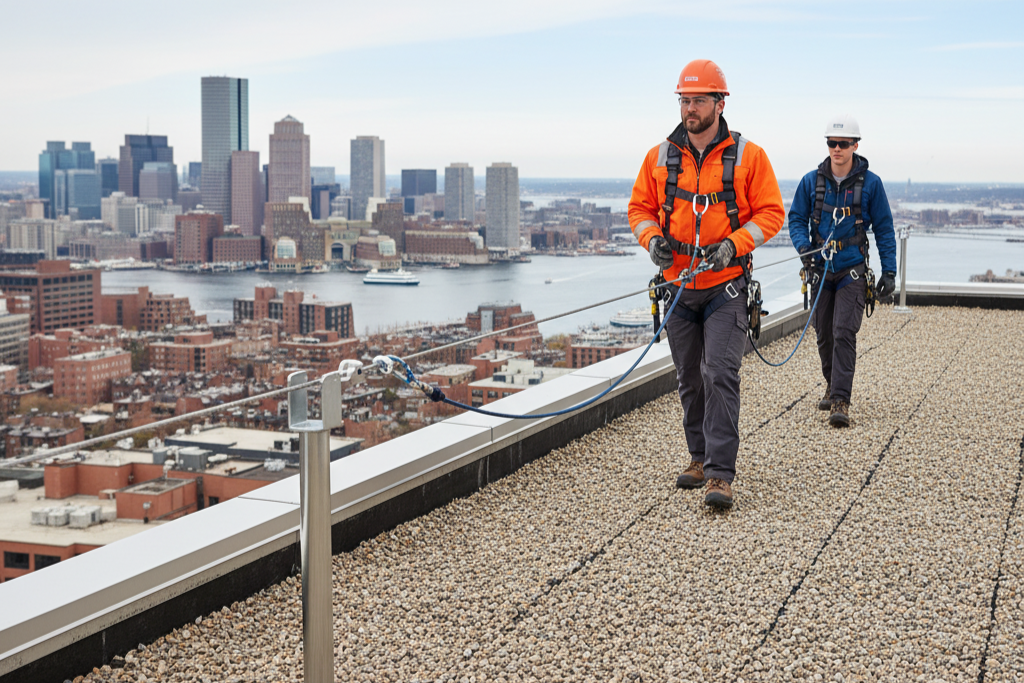
When crews move along long roof edges, stopping to re-hook at every point slows work and increases risk. Horizontal lifelines solve that problem by keeping workers continuously connected as they travel. For property managers and contractors in Boston, MA, these systems reduce exposure at edges, speed up routine maintenance, and bring a practical layer of protection to busy rooftops.
What a horizontal lifeline actually does
A horizontal lifeline is a tensioned line—often a stainless cable—anchored at each end and sometimes supported mid-span. Workers connect with an energy-absorbing lanyard or SRL, then glide past intermediate supports without disconnecting. On multi-building portfolios in Boston, MA, the benefit is simple: fewer stops at the edge, fewer chances to make a mistake, and steadier workflow during seasonal maintenance.
Why this matters in Boston’s real conditions
Wind that funnels off the harbor, freeze–thaw cycles, and rooftop clutter can make basic tie-offs feel clumsy. Horizontal lifelines help crews maintain three points of awareness while moving around skylights, condensers, and parapets common on buildings in Boston, MA. With continuous tie-off, teams handle inspections and light service faster, which is crucial during short winter daylight windows in Boston, MA.
Key advantages you can measure
- Continuous mobility: Fewer clip-and-reclip actions at roof edges. That’s real time saved across large sites in Boston, MA.
- Coverage with fewer anchors: Strategically placed end anchors and intermediates can protect long runs, a smart approach for older roofs in Boston, MA, where penetration planning matters.
- Cleaner workflow: Crews can focus on tasks, not constant reattachment, which reduces error in shifting weather typical of Boston, MA.
- Adaptable to many roof types: Systems can be designed for concrete, steel, and some retrofits common in historic districts in Boston, MA.
Design basics without the engineering jargon
A good system accounts for three things: anchor strength, line deflection, and fall clearance. When a fall is arrested, the line stretches and the worker moves below the roof plane. Designers calculate that deflection and make sure there’s enough vertical clearance above lower levels. On multi-story buildings in Boston, MA, that calculation protects against swing hazards near courtyards, alleys, and recessed facades.
Intermediates keep the line from bowing too much, and pass-through connectors allow workers to glide past supports. End anchors and terminations handle the highest forces, so placement and substrate choice are critical on older roofs in Boston, MA.
Materials and corrosion realities
Coastal air accelerates corrosion. Lifelines for buildings near the waterfront in Boston, MA should favor marine-grade stainless hardware, sealed terminations, and compatible roof flashings. Using components built for harsh environments extends service life and preserves those yearly inspection results that many facility teams in Boston, MA, depend on.
Where HLLs shine—and where they don’t
Horizontal lifelines are excellent for travel restraint and many fall arrest scenarios along straight edges, catwalks, and long parapets. They also pair well with hatch access routes where crews transition immediately into protected zones. For heavy suspended access, davits and tie-back anchors usually take the lead; on several high-rises in Boston, MA, we see a hybrid approach—HLLs for rooftop travel, davits for facade drops.
Training and user-friendly details
Even the best system needs clear labels, intuitive terminations, and user training. Post simple diagrams at roof doors. Include a short “before you clip” checklist. In fast-paced service calls across Boston, MA, these small touches help new techs use the system correctly on day one. Annual refreshers keep crews sharp when vendors rotate between sites in Boston, MA.
Inspection rhythm that actually sticks
Set a schedule you can keep: an annual competent-person inspection, plus quick visual checks before use. Keep a log at the roof hatch and a digital copy tied to your asset list. After severe storms, add a post-event check—this is routine for many teams in Boston, MA, after heavy wind or icy buildup.
Budgeting: the long-game view
Yes, engineered systems are an investment. But over a five-year horizon, many owners in Boston, MA see lower labor hours on routine tasks, fewer temporary anchors to manage, and cleaner compliance records. Standardizing hardware across properties in Boston, MA, also simplifies training and reduces confusion when contractors switch buildings.
Quick selection checklist
- Map the real walking routes at height in Boston, MA.
- Identify edge zones, skylights, and obstacles that dictate line paths.
- Confirm substrate and preferred penetrations on each roof in Boston, MA.
- Specify corrosion-resistant components near the harbor.
- Model deflection and clearance to account for recessed lower roofs in Boston, MA.
- Plan labels, diagrams, and a simple inspection log that workers will actually use.
Next step
Want to reach the facade safely when work gets heavier? Read next: Understanding Davit Arms and Their Applications to see when to shift from rooftop travel protection to suspended access solutions in Boston, MA.
Talk to a team that designs for your reality
Need a walk-through, drawings, or a second look at an older layout in Boston, MA? We’ll review tasks, routes, and substrates, then outline a right-sized plan. Explore Fall protection to connect with our engineers and schedule a short discovery call for your Boston, MA properties.


